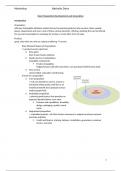Marketing Nathalie Dens
New Proposition Development and Innovation
Introduction
Proposition:
offering, (in)tangible attributes related not just to physical goods but also services, ideas, people,
places, experiences and even a mix of these various elements, offering, anything that can be offered
for use and consumption in exchange for money or some other form of value
Product:
good, only when we refer to a physical offering service
- (Non-)Physical Nature of Propositions
=> product-service spectrum
o Pure good
fruit, frozen foods, toiletries
o Goods-services combinations
intangible components
Product intangibles
fridges/houses sold with warranties, cars purchased with finance deals
o Pure service
cinema ticket, education, hairdressing
- 3 levels of a proposition
o Core proposition
= real core benefit or service, may be a
functional (what product will do) or an
emotional benefit (how product/service
makes people feel)
o Embodied proposition
= physical good/service that provides an
expected benefit/deliver core value
Features and capabilities, durability,
design, packaging, quality, brand
name
o Augmented proposition
= embodied product + all other factors necessary to support purchase and post-
purchase activities
Credit and finance, training, delivery, installation, guarantees, customer
service, warranty
1
, Marketing Nathalie Dens
Classifying physical propositions
- Consumer offerings
classification based on
o Durability
Durable goods:
can be used repeatedly and provide benefits each time they are used,
require purchaser to be highly involved in purchase decision, contain a high
perceived risk so consumers spend time, care, energy searching, formulating,
and making the right decision
Bicycles, music players, refrigerators
Non-durable good:
have a limited duration (perishable) and are often used only once, low levels
of involvement, risk is low so little need to shop around for best possible
price, buyers may buy on basis of availability, price, habit, brand experience
Yoghurt, newspapers, food, grocery items
Services:
intangible propositions that cannot be stored
o Behaviour
Convenience products
non-durable goods or services bought because consumer does not want to
exert much effort, inexpensive, customers know expected price may switch
brands if price exceeds that of the competition, widespread distribution,
convenient locations
Buying behaviour
Routinized response behaviour: Habitual buying, frequent purchase,
little planning/comparison/shopping effort, low consumer
involvement
Subdivided into 3 categories:
staples, impulse, emergency products
=> different marketing strategies required to make each work
Promotion
mass promotion by producer
Shopping products
items consumers shop for, higher price, selective distribution in fewer
outlets
Buying behaviour
Less frequent purchase, search for information, much planning and
shopping effort, comparison of brands on price, quality, style
Promotion
advertising, personal selling by producers/resellers, word-of-mouth
2




